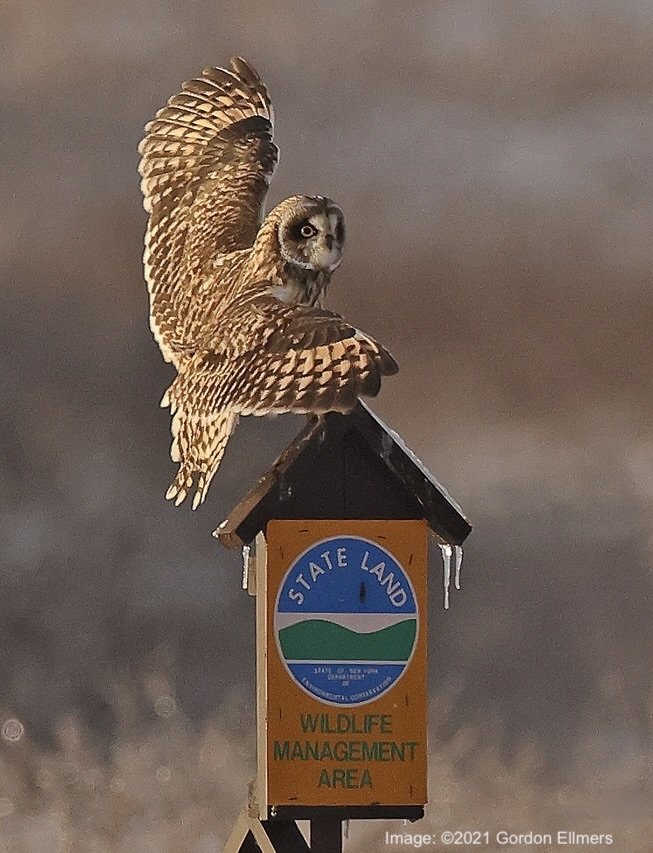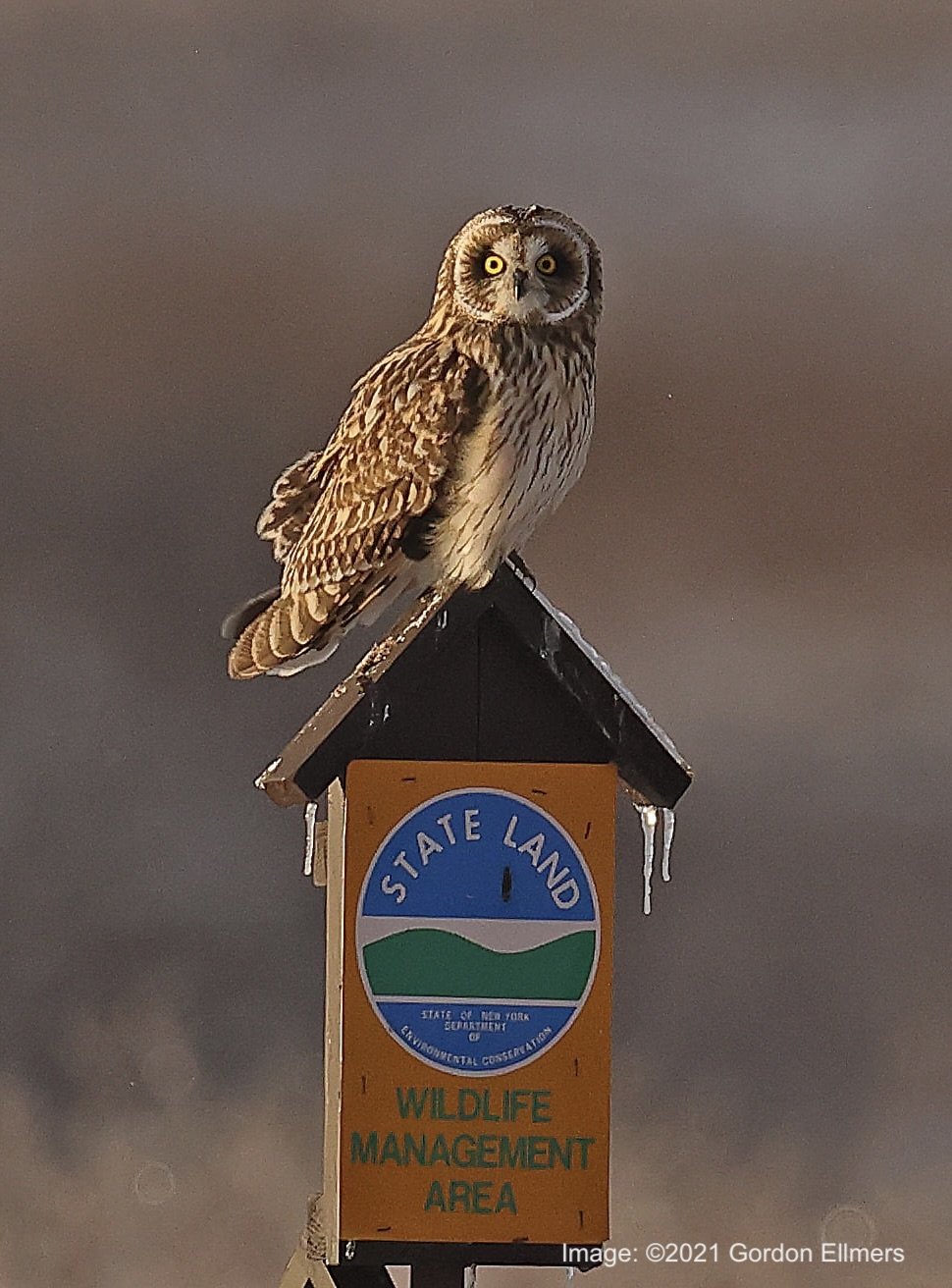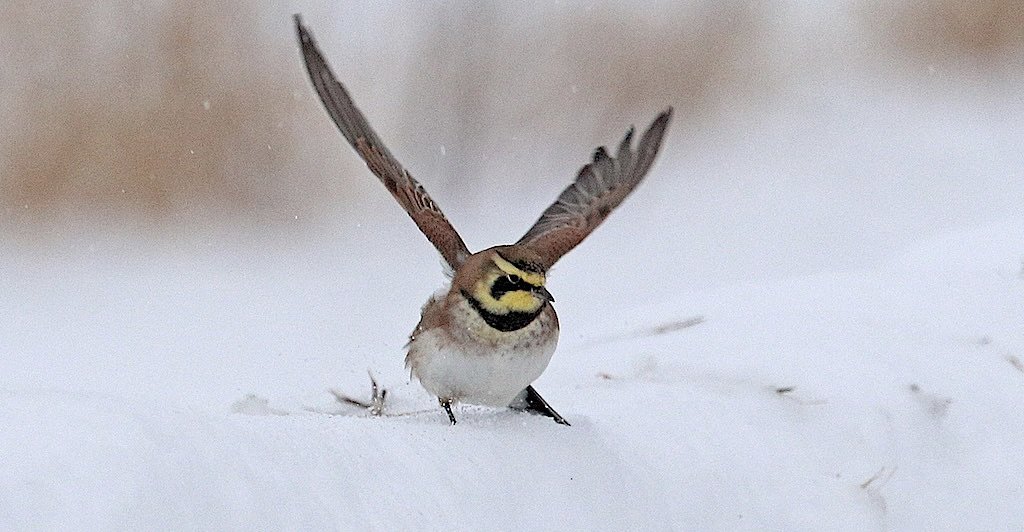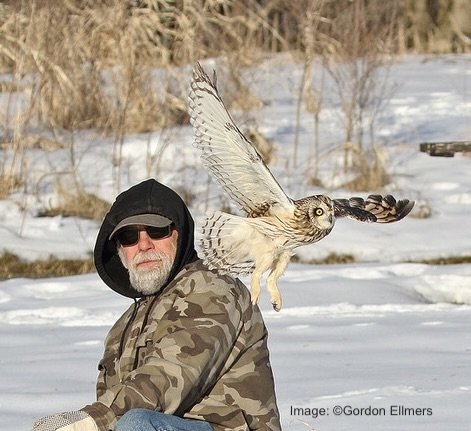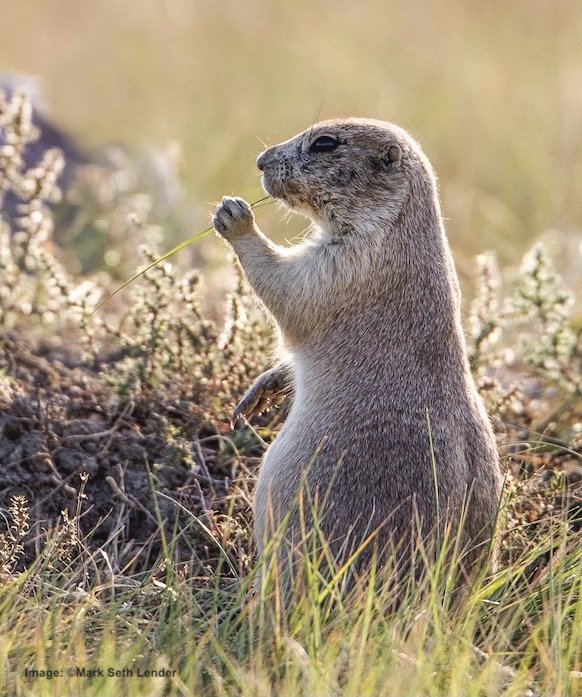Winter Secrets of the New York Grasslands: Snowy Owls, Short-eared Owls, and More
Short-eared on approach to a favorite perch, a wildlife management sign in the Washington County Grasslands IBA (Important Bird Area) Image: ©Gordon Ellmers
Roberta Kravette, editor and grassland lover.
There is Something Out There!
Dusk. Silence has fallen over the field of dry grasses, it stands empty, devoid of life. Or is it? Last summer's frenzy of bobolinks and butterflies is long gone; they disappeared into warmer climes as green fields faded into straw. Only the breeze is left, rustling the dried grasses and softly whistling through its bordering trees.
But something is floating between the field and the sky, ghost-like against those dark trees; a hawk, barely moving its wings, glides along the field's perimeter. Northern Harrier.
Norther Harrier both listens and looks for its next meal as it floats over winter fields at the Grassland Bird Trust. Image: ©Gordon Ellmers
✓ Trip Tips
Where: Grassland Bird Trust, Fort Edward New York. Alfred Z. Solomon Viewing Area.
When: October - March
Later, three short-eared owls swoop in and jostle for position on the "Wildlife area" sign. Finally, one owl perches triumphant – like a punctuation mark to the sign's message.
Then a determined second short-eared owl gains the coveted top spot but is quickly "nudged" off by the first and third shortie.
Two short-eared owl vie over a favorite perch, these owls, with there seemingly boundless determination, always remind me of wide-eyed kids. Image: ©Gordon Ellmers
Trip Tips
Who: Patient, quiet, humans. No pets. Loud noises can flush and weaken the birds.
The action looks more like a game among friends rather than a territory fight – and since short-eared owls tend to stay in small flocks, it probably is. That particular resting spot, overlooking the grass, is a favorite for the resident-barred owl, too. Why?
Simple. That much-beloved sign is the perfect vantage point to watch for their next meal.
The Secret life of Fort Edward’s Grassland
Interested in seeing the winter raptors? Tell us for winter 2024 priority notice.
When we think of "grass" land, we tend to think of the lawn – a single type of bright green turf, diligently sprayed, fertilized, and mowed into an expanse of two-inch mono-species perfection. But, unfortunately, all that "lawn care" leaves little alive; a "healthy” lawn does not have room for much wild to survive.
Grassland is very different; it is a wild open, treeless expanse, a multitudinous sea of various plants and grasses. Grasslands are richly biodiverse, the home of small mammals, insects, and invertebrates, a hotbed of life in the warm summer and secretly in the quiet, frozen winter months. Hidden under snow-covered grasslands, among the stalks of dried vegetation, is an entire ecosystem of mice, voles, insects, and more. Rabbit dens line the perimeter. And owls and hawks glide overhead.
Northern Harrier on the Grassland Bird Trust protected land hunts for mice and voles living in the winter field. Image: ©Gordon Ellmers
I love the color and vitality of Washington County grasslands in the warm months – but in the silent, cold winter, the grasslands are the magic.
Under the dry grass, the abundance of secret life is a magnet for hawks, owls, and delicate songbirds that migrate from their breeding grounds far north in the Arctic. This stretch of dried grasses and scurrying mammals is vital for their survival.
Who might we see here? Cooper's hawks migrate through, as do rough-legged hawks. Northern harriers, many of whom are year-round residents, are more easily spotted against the winter-stark landscape.
Rough-legged hawk with his eye on lunch in the Washington County Grasslands. Image: ©Gordon Ellmers
The hawks glide across the fields, some low like the Northern harrier, listening for the tell-tail rustling of small mammals. Others, like the American Kestrels, watch, waiting to swoop down on a small mammal carelessly coming out into the open.
The hawks and kestrels are fascinating, but when you think the winter show cannot get better, the owls arrive!
Short-eared owls, like wide-eyed kids, chase each other across the fields. But, the barred owl is nonchalant and takes his place on the coveted sign. Then - finally – the moment we have been waiting for: the first snowy owl arrives.
If the short-eared is frenetic and comical, and the barred owl dispassionate, the snowy owl, traveling solo from its' Arctic breeding grounds, is regal; this bird elicits reverence just by its presence.
Snowy owls were hard hit by the avian influenza in 2021-2022. This threatened species needs our grasslands to winter and recover. Image: ©Gordon Ellmers
This winter avian show was once ubiquitous in grasslands and prairies that stretched across North America as far as the eye could see. Unfortunately, only a fraction of the carbon-sequestering, life-giving grasslands and prairies remain today. Most are now acres of "high-yield" chemical-dependent agriculture; or are grazed beyond recognition by meat and dairy animals or paved over or replaced by lawn.
What Makes The Washington County Grasslands Vital for Birds?
Location, Location, Location
Winter sunset at the the Washington County Grasslands Important Bird Area. Image: ©Kurt Ruppel
It is not by accident that the Washington County Grasslands are part of the Atlantic and the Hudson River Flyways, welcoming many avian species in the spring and fall. And the area preserved by Fort Edward’s Grassland Bird Trust is right in the heart of this IBA.
New York's Washington County Grasslands IBA (Important Bird Area) is 13,000 acres spread across Fort Edward, Argyle, and Kingsbury, New York. They nestle within the larger Washington County Grasslands that range from the hills of the county's southern border across its valleys and rolling hills to the Adirondack Mountains in the North.
The first time I saw a great blue heron over-wintering in the wetlands in Washington County I was surprised, but stay they do - note the ice!. Image: ©Gordon Ellmers
The streams and wetlands of the Hudson River Valley and Lake Champlain basin nourish the open fields and meadows. Here is the springtime breeding ground for the (threatened) bobolink, Eastern bluebirds, Savannah, and Grasshopper sparrows. In addition, these grasslands are a refuge for threatened upland sandpiper and sedge wren, and Eastern meadowlark, a species of concern.
I saw my first Eastern bluebird right here in the Washington County Grasslands - in the winter! Image: ©Gordon Ellmers
In the cold months, these preserved grassland acres and resting farm fields are critical habitats for the Short-eared owl (endangered in New York State) and the declining snowy owls, Northern harriers, rough-legged hawks, and horned larks that we have come to see, today. So, yes, the grasslands in winter are magic.
Let's take a look at a few of our winter residents.
The Winter Birds of New York's Washington County Grasslands
Snowy Owl
The fading sun means it is time for snowy owl to leave its fence post perch and hunt. Image: ©Gordon Ellmers
Join us at the Grasslands Feb 2024. More Here
One of the most charismatic of birds is the snowy owl, with its piercing yellow eyes, beautiful white feathers, barred with charcoal or buff; snowy owls are unmistakable. Their extra insulation, necessary for life in the Arctic, makes them one of the heaviest owl species in North America, and at 37-60", the snowy has the 4th largest wingspan of the world's owls (Blakiston's, the Eurasian fish owl, and the Great Grey all average slightly larger)
Snowy owl spends its day resting in the Arctic tundra-like fields of the Washington County Grasslands. Image: ©Gordon Ellmers
When to Look for Snowy Owls: daytime for resting owls, dawn and dusk for snowy owls hunting.
Where to look: Snowies tend to perch high and in the open. So you can find them on rooftops and the tops of telephone poles, But they also roost on the ground in the dried grass. where, during they day, they doze.
Short-Eared Owl
Short-eared owl hunts for mice and voles hidden under the grass and snow, a little snow storm will not stop this hardy bird. Image: ©Gordon Ellmers
You may find short-eared owls across the entirety of North America. Maybe. Unfortunately, their grassland and prairie habitat is in steep decline, and consequently, so are they. In New York State, Short-eared owls are listed as endangered.
Short-eared owls are known to travel great distances over oceans, resting on ships hundreds of miles from shore. But they are "home-bodies" too and are one of the few owl species constructing their own nest, choosing small knolls or ridges on the ground concealed with grass.
Where to Look: Open fields and grasslands. They will rest in trees along the perimeter or on the wildlife signs in the area! The Alfred Z. Solomon Viewing Area in Fort Edward’s Grassland Bird Trust is a great spot.
When to Look: Early morning and early evening are prime shortie hunting hours. They fly low over the fields, seeming to hover and then drop onto prey. Their air-born maneuvering to catch – or avoid becoming prey – or tumbling with each other is thrilling to watch.
Barred Owl
Barred owl in a perimeter tree on the Grassland Bird Trust land. He will swoop down at the first rustle of the little mammals hidden in the grass. Image: ©Gordon Ellmers
The barred is usually a forest owl, but at least one has taken a liking to the Washington County Grasslands. While some owls, like the great horned, can be aggressive, and some, like the snowy, can be skittish, this species is almost easy-going. Perhaps that has helped make it adaptable to the shrinking wild landscape; unlike many other owl species, some barred owls now make their home in and around urban areas. The barred owl that has taken up residence in the Grasslands seems a mellow fellow, but keep your distance – even it needs space!
The barred owl is a big bird with the 6th largest wingspan of worldwide owl species – 37-49." Barred owls hunt from a perch, waiting for mice and voles to wander blithely by – then they silently swoop down and – BAM! Lunch.
Join us in Feb. 2024 for winter raptor watching and photography.
Fun fact: The barred owl played an essential but mostly "unsung" part in American history. At the height of the underground railroad, Harriet Tubman made 13 trips to guide enslaved people to freedom, using the barred owl's call as her signal.
Where to look: Barred owls tend to perch in trees blending into the bark, but our resident owls also like the grassland wildlife signs and fence posts.
Northern Harrier
I love watching the Norther harrier hawk gliding over the grasslands. This is a majestic bird. Image: ©Gordon Ellmers
Northern Harriers are medium-sized raptors with owl-like faces. The unusual shape may help them hear movement in the grass and under snow. The females and immature tend to be darker and brown with dark bands on the tail. The males are grey, and they are the ones who look like spirits floating across the landscape. Both sexes have a white rump patch at the tail base.
Where to Look for Northern Harriers: Look along the field perimeters against the dark line of trees. The Alfred Z. Solomon Viewing Area in Fort Edward’s Grassland Bird Trust.
When to Look for a Northern Harrier: Northern Harriers hunt during the day.
Rough-legged Hawk
Northern Harrier lifts off from its fence-post perch ready to glide low over the field listening for mice or voles. Image: ©Gordon Ellmers
This Arctic breeder has feathers down to its toes! Unfortunately, like the other Arctic birds, it is at significant risk as its primary habitat changes and warms.
Where to Look for a Rough-legged Hawk
Rough-legged hawks hoover over open areas, fields, and grasslands. They also perch high on utility poles and tree branches, watching for movement, ready to swoop down at the first hint of a rodent under the grass; you may be lucky to see it swoop down to catch lunch!
When To Look for a Rough-legged Hawk
Early mornings and dusk are their favorite hunting times. But look for them perched during the day.
American Kestrel
The fierce little American kestrel, smallest of the North American falcons, is a proficient hunter. Image: ©Gordon Ellmers
The American kestrel, our smallest falcon, is a beautiful, feisty little bird that feasts on moths caught on the wing or other invertebrates like grasshoppers and cicadas, and they prey on small snakes. When insects are scarce in the winter, the American kestrel turns to voles, mice, and even small birds.
Where to Look for an American Kestrel:
Look for American kestrels on poles or wires where they will sometimes stay all day – watching. On other days they may flit between perches every few minutes. The Alfred Z. Solomon Viewing Area in Fort Edward’s Grassland Bird Trust is a great spot.
When to Look for an American Kestrel American kestrels are daytime hunters.
Horned Lark
These perky little birds get their name from the feather tufts on the sides of their heads. But I love them for the black mask across their pretty yellow face.
In theory, you might see a horned lark here in the warmer months, but they breed high in the Arctic, returning to our grasslands with the cold and snow. I don't know about you but hearing the sweet song of the horned lark floating on the chilled air warms my heart.
During the winter, horned larks like the company of other species, joining loose flocks of dark-eyed juncos, tree sparrows, and snow buntings – another Arctic resident.
Where to Look for a Horned Lark:
Horned larks prefer areas around grasslands, dry, bare places, mowed fields, and empty regions along roadsides where they forage for seeds and insects. Look carefully; they can be invisible, blending with snow and dirt patches. And remember to scan flocks of small birds; they are probably in the mix!
When to Look for Horned Larks:
Daytime
Snow Bunting
When the frozen air twinkles with ice crystals and fingertips turn blue with cold, the little snow buntings seem happiest. Fun fact: males will head to their Arctic breeding grounds when the temperature can dip to -20F ( c). Our freezing weather does not daunt this little bird.
Where to Look for Snow Buntings:
Snow buntings are ground foragers; look for them in barren crop fields, roadsides, and other empty places. They stay in small flocks, constantly moving from spot to spot, restlessly searching for seeds.
When to look for Snow Buntings:
Daytime. Snow buntings blend very well with snow and dirt patches, but if you suddenly see a flurry of activity, look again. It may be a flock of snow buntings.
Come with us to explore the winter secrets Washington County Grasslands! But Note: Not all species arrive simultaneously or even every year, and the changing climate is making their arrival all the more unpredictable.
And please comment below! We love to hear from you



